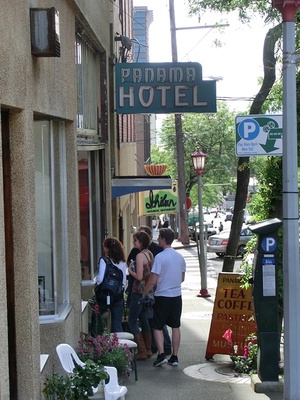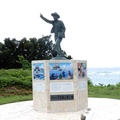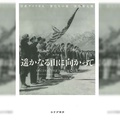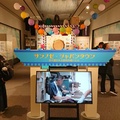Read Part 1 >>
Diverse characters and effective jazz
At that time, they come across a change in the Panama Hotel, which had been closed for a long time. The new owner discovers the belongings of a Japanese family that had been stored and forgotten for many years. There may be some memories of the two of them that are connected to Keiko.
I found it. The past comes back to life, gradually filling the gap between it and my present self, and finally bringing the past to life in the present.
The story has a heavy background of "the situation Japanese people found themselves in during the war," but at the same time, the whole film is permeated with ordinary nostalgia, as middle-aged people who have left the front lines in both their personal and professional lives and feel somewhat hollow, look back on the past. When you meet someone from your past at a class reunion after a long time and come face to face with your old self, there is a touch of sentimentality. This work is also fully equipped with such melancholic elements.
Other characters that add nice flavor to the film include Mrs. Beatty, a white woman who works in the school cafeteria and is a bit rough around the edges but who helps the two out in no time, and Sheldon, a black jazz saxophone player whom Henry opens up to.
In addition, the accent is on jazz, a music that has no direct connection to Japan or China, and cannot be said to be a white music. If the characters are diverse, this kind of structure and consideration also gives the story depth.
The power of stories cannot be acquired through knowledge or information...
Author Jamie Ford is a Chinese American whose great-grandfather immigrated to the United States from China, and grew up in Oregon until the age of 12. At that time, a close friend of his was a Japanese American whose father was the famous Japanese American poet Lawson Fusao Inada. He had been through the internment camps and apparently read Ford's first manuscript.
The Henry in the novel has some similarities to the author himself in that he is the only Chinese student at his school and his best friend is Japanese.
Some in the U.S. public believe that the wartime segregation of Japanese Americans was necessary, but the author does not delve into these political or social issues, instead writing the story as a love story and a family tale. Of course, the story is told against the historical backdrop of the war.
On the other hand, however, by depicting personal stories and exploring the inner world, we reflexively become aware of the emptiness of conflict and discrimination, and are implicitly shown the power to overcome them.
Professor Maeda Ippei of Naruto University of Education, who translated the Japanese version, had this to say:
"Through this work, you can feel the meaning of people understanding and helping each other, beyond ethnicity and nationality. It's not just knowledge and information, but understanding through reading stories - you could say it's the 'power of stories.'"
Perhaps only a story can portray and explore the issues caused by conflicts and disputes between nations and ethnic groups.
Hollywood says, "If you replace the main character with a white person, we'll make a movie out of it."
There are many novels that deal with issues of identity and relationships between men and women, as well as family relationships, that are tormented by circumstances between nations or ethnicities. A relatively recent work of this kind, set in America during the Pacific War, is "Snow Falling on Cedars."
This novel written by David Guterson depicts the tragic love story of a Japanese woman and a white man torn apart by war, and the power to overcome discrimination and prejudice, mysteriously intertwined with a murder case based on historical fact. It was also published in Japan under the translated title " Murder Suspect ."
The novel, which won the 1995 PEN/Faulkner Award, sold more than four million copies in the United States and was later adapted into a film starring Yuuki Kudo as the Japanese-American heroine.
The bestselling novel "The Panama Hotel" was also approached by the Hollywood film industry for a film adaptation. However, there was an opinion that one of the main characters should be white, unlike in the original novel. This is a typical Hollywood idea aimed at appealing to the general public, but the author Ford reportedly opposed it, saying that it would destroy the world of the novel.
Finally, I would like to mention the Panama Hotel, which serves as a symbol of memory in this novel.
The hotel still stands today in a corner of the former Japanese town, now known as Seattle's International District.
It was built by a Japanese architect in 1910 and has welcomed many immigrants from Japan.
When the war began and Japanese Americans were forced to give up most of their possessions in order to be taken to internment camps, some of their luggage was left at this hotel.
In 1950, the hotel closed with unclaimed luggage remaining, but in 1986 a Seattle-based artist, a white woman of Scandinavian descent named Jean Johnson, bought it and reopened the hotel, considering the Japanese immigrant culture a historical heritage.
The first floor of the hotel is an Asian-themed cafe that also displays photographs depicting the state of Japantown at the time and various items related to Japanese immigrants.
I have visited this traditional, relaxed café several times, and even stayed there once out of curiosity. When I stopped by this summer, Roger Shimomura, a famous Japanese-American artist, was sitting alone at a table. It is easy to see how Jamie Ford's imagination was stimulated by this hotel and how it expanded his story.
(Titles omitted)
*This article is reprinted from JB Press (Japan Business Press) (published on October 30, 2012).
© 2012 Ryusuke Kawai, JB Press











